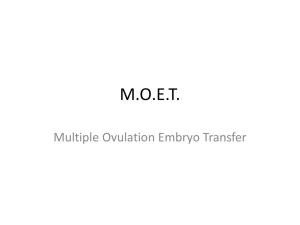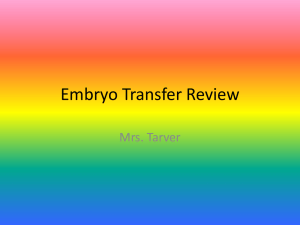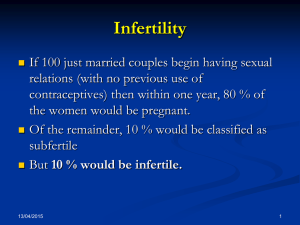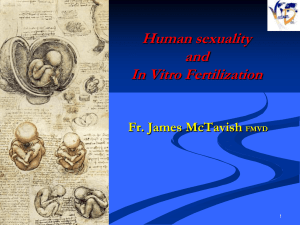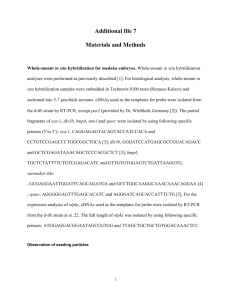MOET in Sheep presentation
advertisement
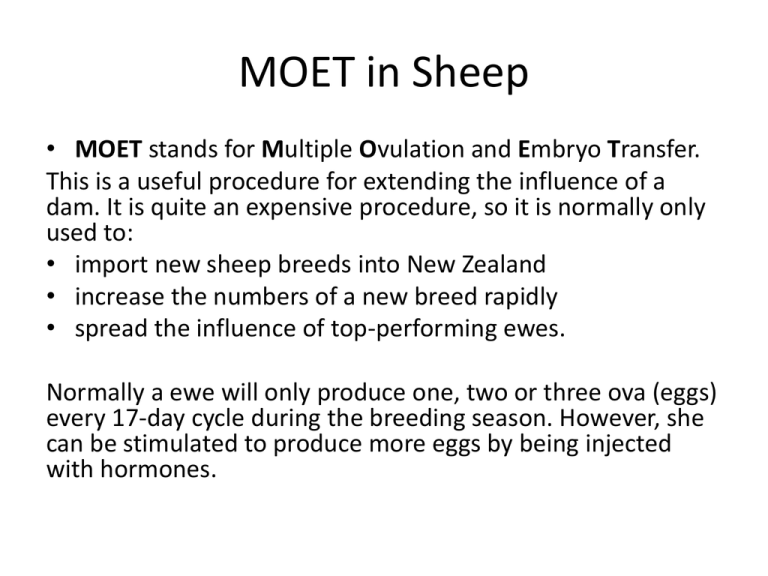
MOET in Sheep • MOET stands for Multiple Ovulation and Embryo Transfer. This is a useful procedure for extending the influence of a dam. It is quite an expensive procedure, so it is normally only used to: • import new sheep breeds into New Zealand • increase the numbers of a new breed rapidly • spread the influence of top-performing ewes. Normally a ewe will only produce one, two or three ova (eggs) every 17-day cycle during the breeding season. However, she can be stimulated to produce more eggs by being injected with hormones. • Following insemination (by natural mating or artificial insemination), these ova are fertilised. The ewe now has more embryos than she would normally produce. • Carrying more than three lamb embryos causes problems, however. The lamb embryos are not so likely to survive, and the lambs born will be smaller and more likely to die. • Therefore, lamb embryos are collected before they have implanted into the donor ewe. A catheter is used to flush out the embryos from the donor ewe. The embryos are put into several recipient dams. These recipient dams have been synchronised by hormones to come into oestrus. The recipient dams will carry the embryos until birth, and mother the lambs once they are born. • The embryos from the donor ewe can be frozen and stored in liquid nitrogen to be transported and used later. STAGES BEFORE COLLECTING EMBRYOS • 1. Preventing ewes from coming into oestrus (heat). A slow-release progesterone device called a CIDR is inserted into the vaginas of donor and recipient females to stop them coming into heat. • CIDRs (pronounced see-dars) stay in the sheep for 13 days A CIDR for sheep • The cuff (like a tiny balloon) of the catheter is blown up carefully, sealing the end of the uterine horn. A Foley catheter with syringe to blow up the cuff 4. Flushing out the embryos • Using a much finer catheter (actually an intravenous catheter such as the ones used to administer -“drips”- to humans and animals), a specially prepared embryo flushing solution is injected into the horn at the uterine junction end (up near the fallopian tube) and 20mls is flushed through the horn and out of the Foley catheter into a sterile petri dish. • The donor animal is under general anaesthetic and held on a tilted trolley. The angle lets the intestines fall out of the way of the reproductive tract. • The operator places the uterus on the outside of the animal (through a cut in the abdomen) and injects the embryo flushing solution. The reproductive tract can be seen on the blue sterile drape. The delicate ovaries remain protected inside the abdomen under the cut. The operator is injecting the solution to flush out the embryos for collection • 6. The dish is taken to a microscope where the embryologist finds the embryos in the dish and checks them. They are checked to see that they have been fertilised and are healthy, and then transferred (via a fine pipette) to a holding solution ready for implantation. If the egg has been fertilised it will have divided into an embryo. The only way to see if the egg has divided is by looking at it through a microscope. Eggs that are unfertilised or unhealthy are discarded. • 7. The surgical wound in the donor’s abdomen is stitched closed and the ewes are left to recover from the anaesthetic. IMPLANTING EMBRYOS INTO THE RECIPIENT EWES • Recipient ewes that have had a heat six days prior (at the same time as the donor ewes) are given a sedative and prepared for surgery. Their reproductive cycles are -“in step”- with the donors’ cycles and their reproductive tracts are in a similar state to the donor animals. This is important so that the transferred embryos will be accepted, and able to survive, implant, and continue their development in the recipient ewe. • 1. Using a laparoscope, the tip of the uterus is found and held with forceps, and then pulled out to the exterior of the animal through a small cut in the abdominal wall. 2. The embryos (usually two are transferred into each recipient) are sucked up into a catheter, and the tip of the catheter is inserted into the tip of the uterine horn. The tomcat catheter is attached to a small syringe and the embryos (along with a small volume of embryo-hold solution) are squeezed out into the uterine horn. They end up in a similar position in the recipient’s uterus to the position they were occupying in the donor’s uterus. 3. As the incision in the recipient animal is very small, internal layers heal naturally, and a single suture (stitch) is placed in the skin to close the wound. It takes about 15—20 minutes to flush and stitch up a donor, and about 2 minutes to implant a recipient. • 4. Approximately 145 days later the recipient ewe gives birth. The lamb(s) is born with the genetics of the donor dam and sire. The recipient mother does not recognise them as anything other than her own offspring – even though, in the case of some breeds they may be significantly different to the recipient mother. • Recipients must be in good health at the time of transfer and be able to successfully maintain a pregnancy, give birth and feed offspring well. • Not every transplanted embryo survives and successfully results in a pregnancy. Of the two embryos usually transplanted into a recipient, one, both or none may survive. A typical survival rate for ET in sheep would be 70—80%.


